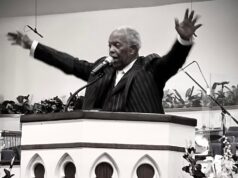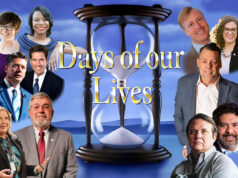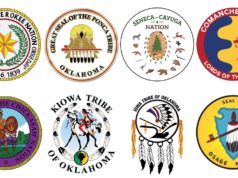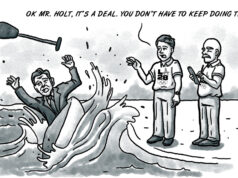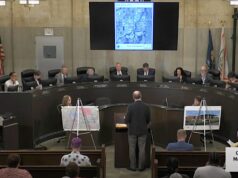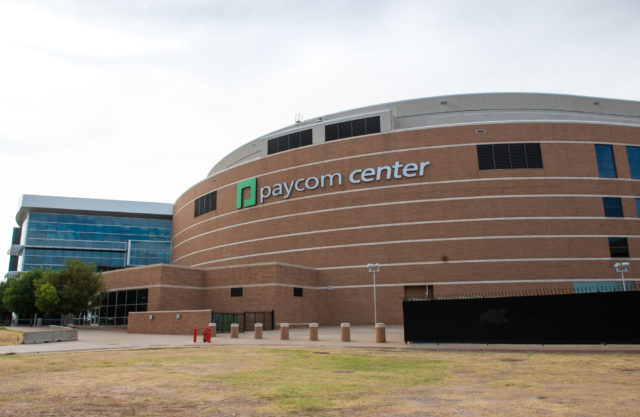

Since the Oklahoma City Thunder arrived in 2008, fans have experienced the full range of emotions: the novelty and first hopeful steps of a new team, the rarified air of an NBA finals appearance and the heartbreak and bitterness of losing beloved star players to other teams.
Now, as Thunder supporters await the moment when team executives stop tanking to improve draft position and choose to field a competitive roster, new anxiety and uncertainty have entered the proverbial chat: City officials and Thunder brass have proposed the very expensive and potentially difficult process of hashing out a new arena proposal.
Although city officials and the Thunder have quietly been talking about it for a while, Mayor David Holt introduced the concept of a new arena in his State of the City address July 14.
“Look, here’s the bottom line,” Holt said in his annual speech. “The NBA has changed our city forever. The vast majority of our residents know that and want that relationship to continue. The facts speak plainly that we can never rest on our laurels and we must always be proactive.”
The conversation about a new arena — including cost, potential public financing and location — has already featured pushback from some taxpayers and speculation about whether the Thunder ownership group might sell the team or move it to another city.
New arena would cost vastly more than current facility
In 2008, the Thunder agreed to 15-year lease on the current Paycom Center, which would have ended next year. But the franchise and city signed a three-year extension in 2022 that will keep the team there through the 2025-2026 season.
Paycom Center was a bargain when it opened in 2002 as the Ford Center. Owned by the City of OKC, it cost just $89.2 million to build, though industry experts did not consider it a full-time NBA venue when it was designed. Concerts, minor league hockey, monster truck events and rodeos were the most likely to call the arena home when it opened. But after Hurricane Katrina temporarily brought the Hornets to OKC in 2005 and the city got its own team three years later, that anticipated role changed for good.
Since then, the city has put more money into the downtown facility. In 2008, more than 60 percent of voters approved a 15-month, 1-cent sales tax package that included arena improvements and a new practice facility for the team at a cost of more than $100 million.
But if the city builds a new arena for the Thunder this decade, the cost will be much higher. The NBA has seen five of its teams build new arenas in the last decade. The biggest “bargain” of the bunch is the Golden 1 Center, now home to the Sacramento Kings. Costing $558 million, that facility opened in 2016 after years of drama that included proposals to move the team to another city.
Home to the Detroit Pistons, Little Caesars Arena opened in 2017 and cost $863 million.
None of the other three arenas have been built for less than $1 billion. Chase Center (home of the Golden State Warriors) was built at a cost of $1.8 billion, while the Barclays Center (home to the Brooklyn Nets), opened in 2012, at a cost of $1.18 billion.
Even in middle America, new arena costs can exceed $1 billion. The Fiserv Center is the home of the Milwaukee Bucks. It opened in 2018 at a cost of $1.2 billion. Milwaukee is in a slightly larger media market than Oklahoma City, but it is the 31st largest city in the U.S. by population, while OKC is 20th.
Of the five most recently opened NBA arenas, most are publicly owned facilities.
The Golden 1 Arena is owned by the City of Sacramento. Barclays is owned by the Empire State Development Corporation, a public service corporation. (Public service corporations are similar to private corporations in their structure, but they are publicly owned.)
Fiserv is owned by the Wisconsin Center District, which is also a public entity. Little Caesars Arena is owned by the Downtown Development Authority, which is a part of Detroit city government. However, some improvements to the arena, also home to the Detroit Red Wings of the NHL, have been made by that team’s owners in recent years.
Only the Chase Center in San Francisco was privately financed by a team’s ownership group. The Golden State Warriors group owns its arena outright.
Considering those market comparisons, early chalkboard estimates of the cost for a new basketball arena in Oklahoma City appear to range from $500 million to $1 billion, depending on specific plans, land costs and uncertain building material prices.
Fans, residents weigh in on new arena
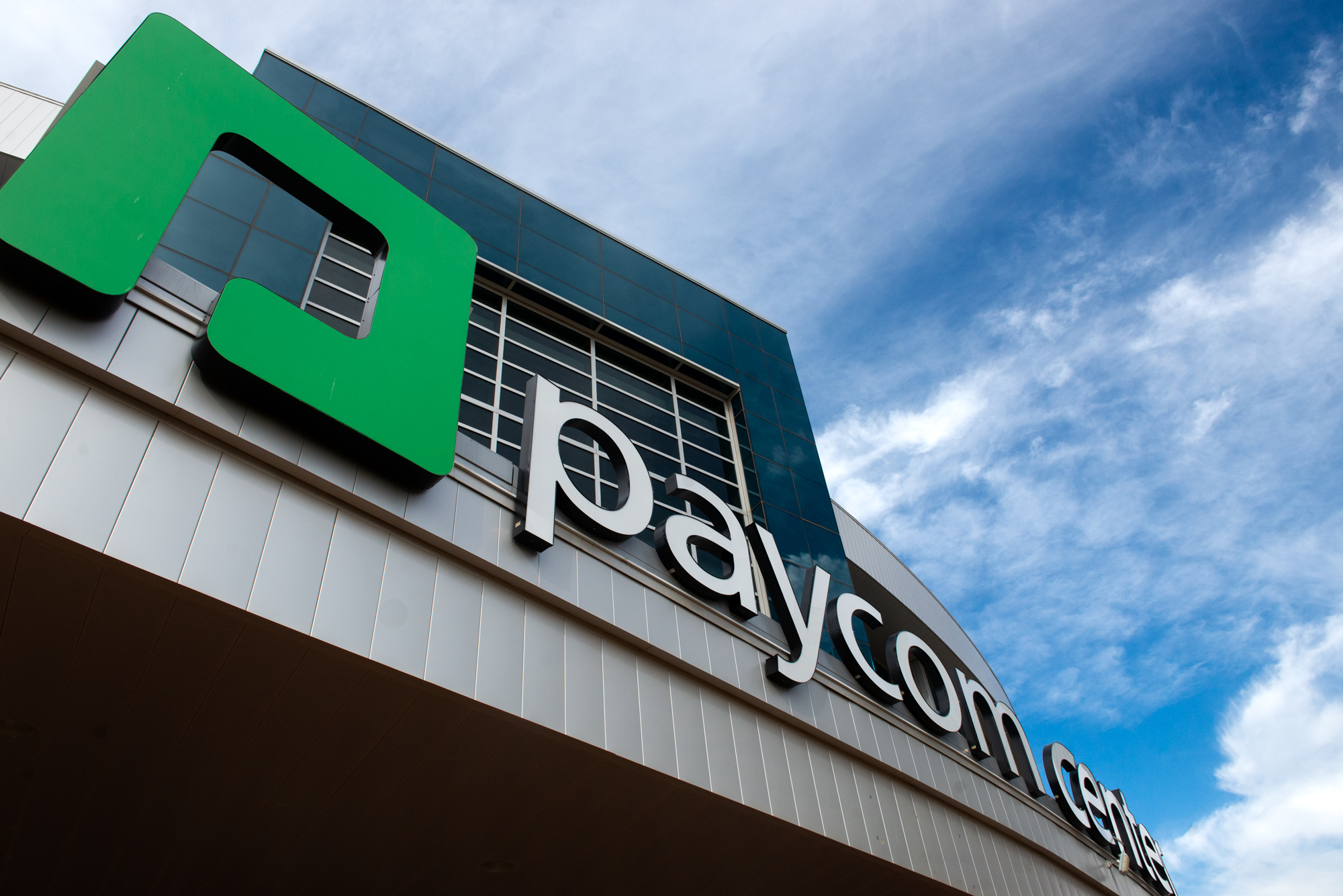
The fine print on how much the arena will cost and how much the team will contribute remains unclear. Aside saying the city needed to hit pause on using $70 million in MAPS funds earmarked for Paycom Center improvements, Holt did not offer specifics about a new arena proposal in his speech because those details are largely unknown at this stage.
OKC native Clay Bennett and others paid $350 million to buy the Sonics and move them from Seattle. Today, the franchise is worth $1.6 billion, according to Forbes.
Given that exponential growth in value, some believe Thunder owners should pick up a substantial portion of the cost of a new arena, especially in a city where leaders recently convinced voters to pass a MAPS 4 packaged that includes construction of a $37 million soccer stadium and concert venue, as well as a $63 million coliseum at the State Fairgrounds.
The discussion has percolated on social media this month:
No. Kinda feel like all the other NBA cities that get held hostage for updates when initial promises of arena longevity & prosperity sharing go unfulfilled.
Not liking it at all.
Build the MPS first. Do it right. Maybe the city should be more concerned with current obligations.— DJ The EnergyFC Kilt Guy (@Cavedaddy) July 15, 2022
So many studies done about how new arenas are merely a leverage play for wealthy team owners. Arenas themselves do not provide the economic boost. But owners will use the fear of moving a team to another city to appropriate taxpayer dollars for an unnecessary project.
— neb (@Donut_Artisan) July 15, 2022
We can’t keep subsidizing the rich. If the owners of the Thunder won’t keep the team here without a new taxpayer funded arena, let them leave.
— Spencer L. Hicks (@SpencerLenox) July 16, 2022
While others just want to keep the team in town by any means necessary.
The Thunder have had an immense impact on my life personally and mean so much to me. Life in OKC post Thunder has been astronomically better than pre Thunder. (big boost.) I for one will vote yes for Arena (if it comes to a vote). ⚡️🏀 pic.twitter.com/7dAOiN4SAF
— Logan Meyer (@Logmey92) July 17, 2022
I’m a Thunder fan outside of OKC. I never would have visited the city but for the Thunder (attended OKC vs GSW). The Thunder brought a lot of goodwill to the city (I saw Thunder flags everywhere). It’s OK to pay for things you like and appreciate. A new arena is no different.
— KSPN ⚡️⚡️ (@Kbellinger12) July 16, 2022
Holt doesn’t put much stock in the current value of the team as a counterpoint to public financing of arenas and stadiums.
“I don’t know at this point where the money will come from,” Holt said in an interview with NonDoc. “I couldn’t speculate on that. But as far as the value of the team, that’s not really relevant. That’s not something you realize until you actually sell. It’s like an O. Henry story. If I had a Van Gogh on the wall I would be rich, but I would be cash poor because I wouldn’t realize the value of the painting until I sold it.”
Concerns about abandoning or putting MAPS 4 projects on pause to fund a new arena are also unfounded, Holt said.
“Some of that money is for the current arena anyway, but all of the other MAPS projects still exist, and we would never divert funds away from those projects,” he said.
Holt said that by making the new arena a centerpiece of his State of the City remarks, he intended to get the discussion into the public. The Thunder and the city have been talking about a new arena for years. Now begins the public process of that discussion.
“The point was to let everyone know this is a thing, to let everyone know that there is a discussion and the lease is about to expire,” Holt said. “I don’t think that was on a lot of people’s radar, and I knew we had to start somewhere. Plus, I wanted people to be a part of the dialogue.”
Follow @NonDocMedia on:
OKC City Council members weigh in, sort of
In addition to Holt, NonDoc reached out to all members of the OKC City Council. Some are more enthusiastic than others about a new arena.
Ward 5 Councilman David Greenwell is one of the most fiscally conservative members of the council. He said he sees a city with more immediate needs.
“I would say my initial reaction would be that I need more details,” he said. “I believe there are more pressing issues facing the city beyond a new basketball arena, especially when you look at attendance this past season, which seemed at half capacity.”
Thunder attendance has dipped in recent years as the team’s fortunes have become more downbeat. During the team’s salad days of the early 2010s, the Thunder ranked in the top half of the league in attendance, limited only by the size of its arena as fan enthusiasm went through the roof. Last year, in another season that saw the team miss the playoffs and make roster decisions aimed at a longterm rebuild, the Thunder finished 28th in attendance out of 30 teams.
Greenwell wondered if some of the newness of the team has worn off and whether fans are just less interested in long NBA regular seasons. Either way, he doesn’t get the rush.
“The thing I hear most from people is about the conditions of our streets,” he said. “We have arterial streets that have problems. We have a homeless problem that is a growing concern. If we do get a new arena, I think the city should be compensated in the same way the players and owners are.”
Holt bristled at the idea a new arena would be better received 10 years ago when the team made the NBA finals and was loaded with all-stars like Kevin Durant, Russell Westbrook and James Harden.
“If that is really the question, I think my response would be whether or not you believe in professional sports in Oklahoma City,” Holt said. “Win-loss records are ever-changing, and teams go up and down. When the Sonics relocated, they had a worse record than any Thunder team, yet we were thrilled to have them. It’s not necessarily about wins and losses, it’s about having professional sports teams, especially when you don’t have one. It has defined us and made us different.”
Ward 2 Councilman James Cooper also said the city has other needs, and if he is reelected in 2023, he said those are what he will focus on.
“My main priorities are the Regional Transit Authority and finishing what we started when I was on COTPA,” he said. “That’s a priority for me. The second priority are things like drainage and street resurfacing. We have $1 billion in needs for streets and sidewalks. We need more streetlights. I know that sounds boring to everyone, but those things matter too.”
Cooper still sees the Thunder as an important facet when it comes to the city’s image. Cooper, who teaches English at Oklahoma City University, often asks students to compare the renaissance of Florence, Italy, with that of OKC over the last 15 years. He calls it a way to foster discussion and make material more relatable.
“One of the main things we get into is what role the Thunder have played in OKC’s renaissance story, and it’s always an interesting discussion,” Cooper said. “They might be split on sports as art, but I think the majority understand that role, particularly after they finished reading Boomtown.”
Ward 8 Councilman Mark Stonecipher said conversation about a new arena is about keeping the Thunder in town, and in turn, keeping up the municipal momentum. Stonecipher noted that, since the Thunder arrived, OKC has gone from the 37th largest city in the U.S. to the 20th while resident satisfaction remans high.
“Will Rogers once said, ‘Even if you are on the right track, you’ll get run over if you just sit there.’ Now is not the time to hit the brakes,” Stonecipher said. “Remember what happened when Seattle did not want to invest in a new arena? There are at least 18 major cities that would love to have an NBA team, including Las Vegas. I want to remind everyone what happened to OKC with the National Finals Rodeo and Las Vegas. So, let’s keep growing our OKC economy.”
Ward 1 Councilman Bradley Carter, Ward 3 Councilwoman Barbara Young, Ward 4 Councilman Todd Stone, Ward 6 Councilwoman JoBeth Hamon and Ward 7 Councilwoman Nikki Nice did not respond to emails, phone calls and texts seeking comment on the proposed new arena.
Williams: NBA and OKC are a good match
Team owner Clay Bennett has credited Oklahoma City Chamber President Roy Williams as being one of the most helpful people in getting the Thunder to OKC. Williams said believes the team and OKC have been an ideal match, something he wants to see continue.
“It’s been a discussion for a long period of time,” Williams said. “When you look back at it, we spent around $90 million for the arena. It’s a bare bones building. And of course, it wasn’t built with an NBA franchise in mind. It was more about getting the NHL. Had we known we would someday get an NBA team, it would have been built differently. The technology and everything else has changed in that time. So it becomes a question of how long we can compete with a bare-bones building.”
Williams is not certain how a proposed new arena would be financed, but he said residents can expect the cost to be shared.
“I think the trend is it’s not 100 percent paid for by the city, and that the ownership has a vested interest as well,” Williams said. “I will venture to guess it will be multi-faceted as far as how it gets done. It could encompass a number of different revenue streams, like a TIF district. There could be a number of different resources that could go into something like this other than a penny sales tax. There will be multiple options with the financing.”
Could the Thunder actually leave OKC?
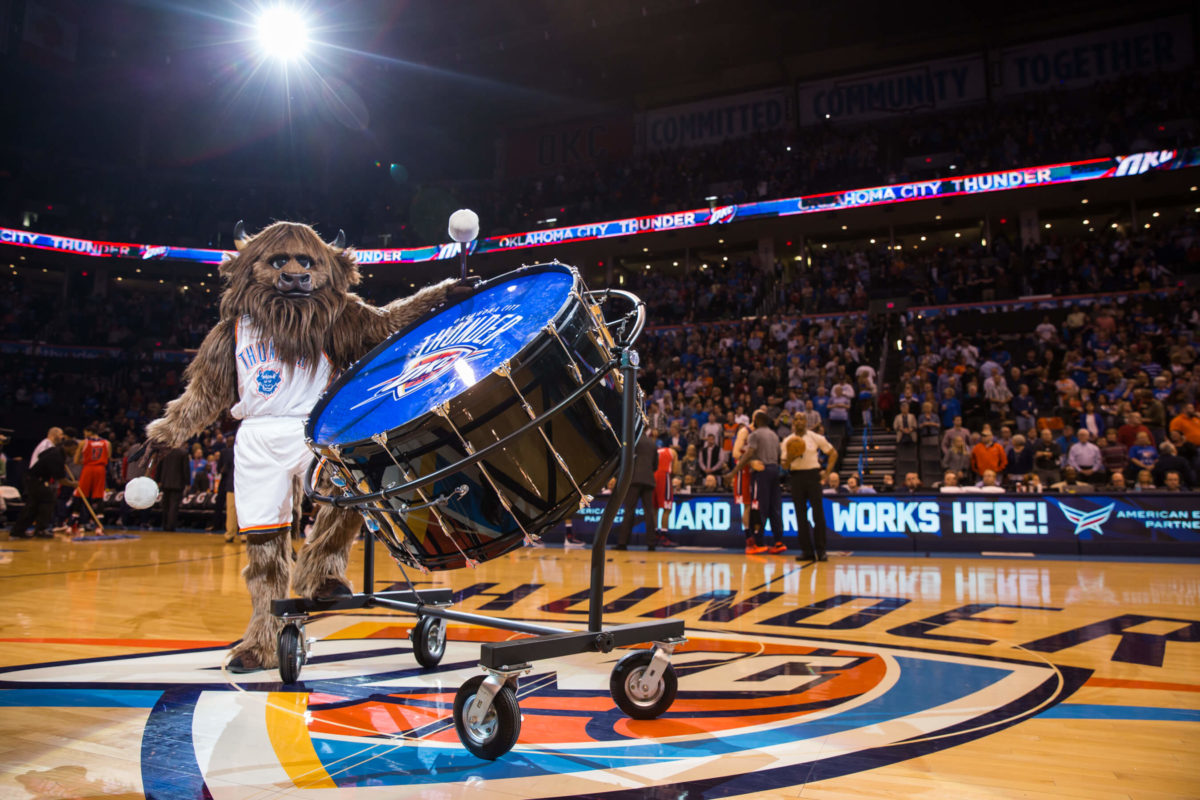
In their push for a new arena, proponents have some relevant and relatable history to draw from. The Seattle SuperSonics relocated and became the Oklahoma City Thunder after Seattle and the team could not come to an agreement on a new arena.
While the new arena discussion between Oklahoma City and the Thunder has started out friendly enough, differences often arise during such negotiations, and things can turn nasty. The NFL’s Raiders moved from Oakland to Las Vegas after a long and protracted fight over a new stadium. In the NBA, the Kings nearly left Sacramento a decade ago amid disagreements between their ownership and the city over a new arena.
Often, the threats to leave seem to have more bark than bite. But if Oklahoma City and the Thunder are unable to come to an understanding about a new arena, Kansas City or Austin could be waiting in the wings. While the Thunder’s ownership group is Oklahoma based and features community leaders like Clay Bennett, George Kaiser and Bob Howard, business is business. If a lucrative offer to buy the team came amid tumultuous discussions on a new arena, anything is possible.
“Certainly my goal is not to have that situation,” Holt said when asked about the potential for prickly negotiations with team owners. “We have the best case study in the world as far as how this can go wrong, which is how we got a team. We’re blessed that we know each other and have worked with each other, and not just on sports-related issues.”
Williams said ultimately it comes down to business when assessing the actual risk of the team leaving.
“I think there is some risk that we could lose the team if we can’t come to an agreement,” Williams said. “People have to remember, it’s a business, and at some point decisions get made based on that. This is something that we don’t necessarily need to do tomorrow, but we do need to start the discussion, and the mayor has done that.”
(Update: This article was updated at 10:08 a.m. Tuesday, July 28, to provide more context about the reason NBA franchises “tank.”)










